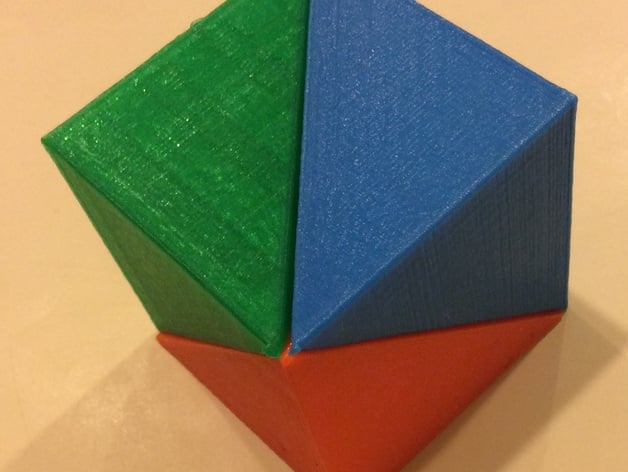
Discovering Volume Formulas
thingiverse
This activity is designed for a geometry class where students discover volume formulas by stacking copies of a chosen 2-dimensional object. Students then analyze a model that splits a cube into three pyramids and develop the pyramid volume formula. Printer Settings: Printer Brand: MakerBot Printer: MakerBot Replicator Rafts: Yes Supports: No Resolution: Standard Infill: 10% Designing This Project: I used Tinkercad to design the squares that stacked. I employed 123D Design to split the cube up. Initially, I created a polyline to obtain a triangle on one of the cube faces [Figure 1]. Then, I extruded the triangle to take it away [Figure 2]. Next, I turned the object and performed the same action for each side [Figure 3]. Three copies of this pyramid are required to fit together and form the cube. To enable these three pyramids to stick together, several options were considered. These include using Velcro dots or magnets [Figure 4]. I used magnets found at a craft store: https://www.sbarsonline.com/sbars/p-8122-mag-208.aspx. Standards: CCSS Overview and Background: Project: Discovering Volume Formulas Students will utilize 3D printed objects to visualize the volume of various objects. They will develop several volume formulas. Lesson Plan and Activity: First, ask students to choose a 2-dimensional object and print five copies of it. Alternatively, have these already printed or provide students with cardboard and scissors to make the shapes. Students will determine the volume formula for the 3-dimensional object created by stacking the five copies and share their formula with the class. Next, show students the model featuring three pyramids forming a cube. They will use this model to devise the formula for the volume of a pyramid with a square base and then generalize it to a pyramid with any base. Skills Learned: HSG.GMD.A.1 HSG.GMD.A.3 HSG.GMD.B.4 Duration of Lesson: This activity will take one to two days. Preparation: Students should have already studied 2-dimensional objects, such as squares, rectangles, and circles. They need to know the area formulas for these 2-dimensional objects. Rubric and Assessment: Here is a sample rubric to use with the worksheet: Question (points) 1 (2) 2 (4) 3 (3) 4 (2) 5 (4) Total: 15 References: Students can be given an area formula sheet, such as the one found here: http://www.mathsisfun.com/area.html
With this file you will be able to print Discovering Volume Formulas with your 3D printer. Click on the button and save the file on your computer to work, edit or customize your design. You can also find more 3D designs for printers on Discovering Volume Formulas.
